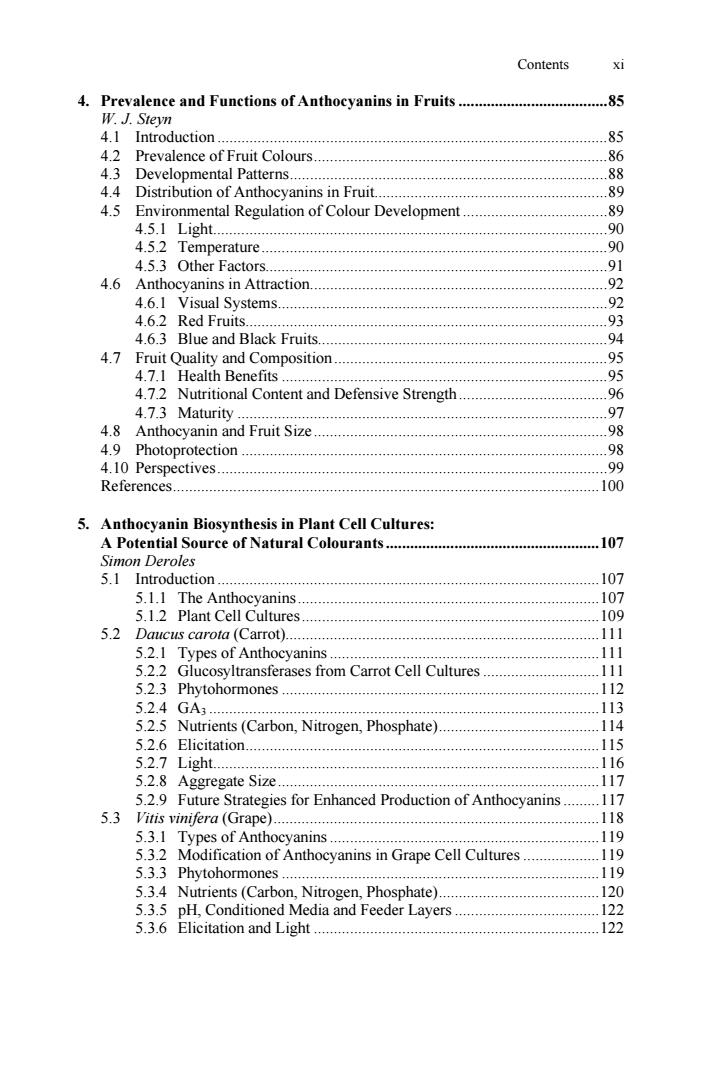正在加载图片...

Contents XI 4.Prevalence and Functions of Anthocyanins in Fruits .85 luction 85 43 Prevalence of Fruit Colours. 4 Distribution of Anthocyanins in Fruit 4. Environmental Regulation of Colour Development.. 4.5.1 Light. 4.5.2 Temperature 4.5.3 Other Factors. 9 4.6 Anthocyanins in Attraction. .,92 4.6.I Visual Svstems. 92 4.62 Red Fruits 95 4.6.3 Blue and Black Fruits 94 4.7 Fruit Quality and Composition .95 4.7.1 Health Benefits. .95 4.7.2 Nutritional Content and Defensive Strength .96 473 Maturity .97 4.8 Anthocyanin and Fruit Size 98 49 Photoprotection. 99 4.10 Perspectives. 99 References 100 5.Anthocyanin Biosynthesis in Plant Cell Cultures: A potential souree of natural colourants 107 Simon Deroles 5.1 Introduction 107 5.1.1 The Anth 10 5.1.2 Plant Cell Cult 52 D 111 52.1T 522 pes of Ar 523 erases from Carrot Cell Cultures 112 54 525 s(Carbon,Nitrogen,Phosphate) 526 ation 527 5.2.8 ght 529 Aggregate Size trategies for Enhanced Production of Anthocyanins. 5.3 Vitis vinifera (Grape). 118 5.3.1 Types of Anthocyanins. 5.32 Modification of Anthocyanins in Grape Cell Cultures 11y 5.33 Phytohormones 5.34 Nutrients (Carbon. Nitrogen,Phosphate).. .120 53.5 pH,Conditioned Media and Feeder Layers. 122 5.3.6 Elicitation and Light.. .122Contents xi 4. Prevalence and Functions of Anthocyanins in Fruits .....................................85 W. J. Steyn 4.1 Introduction .................................................................................................85 4.2 Prevalence of Fruit Colours.........................................................................86 4.3 Developmental Patterns...............................................................................88 4.4 Distribution of Anthocyanins in Fruit..........................................................89 4.5 Environmental Regulation of Colour Development ....................................89 4.5.1 Light..................................................................................................90 4.5.2 Temperature......................................................................................90 4.5.3 Other Factors.....................................................................................91 4.6 Anthocyanins in Attraction..........................................................................92 4.6.1 Visual Systems..................................................................................92 4.6.2 Red Fruits..........................................................................................93 4.6.3 Blue and Black Fruits........................................................................94 4.7 Fruit Quality and Composition....................................................................95 4.7.1 Health Benefits .................................................................................95 4.7.2 Nutritional Content and Defensive Strength .....................................96 4.7.3 Maturity ............................................................................................97 4.8 Anthocyanin and Fruit Size.........................................................................98 4.9 Photoprotection ...........................................................................................98 4.10 Perspectives.................................................................................................99 References..........................................................................................................100 5. Anthocyanin Biosynthesis in Plant Cell Cultures: A Potential Source of Natural Colourants .....................................................107 Simon Deroles 5.1 Introduction ...............................................................................................107 5.1.1 The Anthocyanins...........................................................................107 5.1.2 Plant Cell Cultures..........................................................................109 5.2 Daucus carota (Carrot)..............................................................................111 5.2.1 Types of Anthocyanins ...................................................................111 5.2.2 Glucosyltransferases from Carrot Cell Cultures .............................111 5.2.3 Phytohormones ...............................................................................112 5.2.4 GA3 .................................................................................................113 5.2.5 Nutrients (Carbon, Nitrogen, Phosphate)........................................114 5.2.6 Elicitation........................................................................................115 5.2.7 Light................................................................................................116 5.2.8 Aggregate Size................................................................................117 5.2.9 Future Strategies for Enhanced Production of Anthocyanins .........117 5.3 Vitis vinifera (Grape).................................................................................118 5.3.1 Types of Anthocyanins ...................................................................119 5.3.2 Modification of Anthocyanins in Grape Cell Cultures ...................119 5.3.3 Phytohormones ...............................................................................119 5.3.4 Nutrients (Carbon, Nitrogen, Phosphate)........................................120 5.3.5 pH, Conditioned Media and Feeder Layers ....................................122 5.3.6 Elicitation and Light .......................................................................122